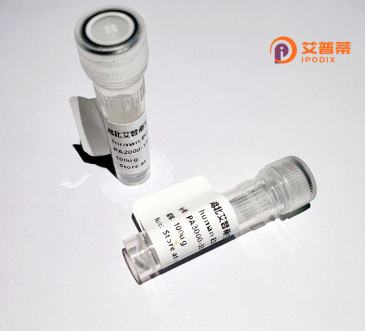
| 纯度 | >90%SDS-PAGE. |
| 种属 | Human |
| 靶点 | RPP38 |
| Uniprot No | P78345 |
| 内毒素 | < 0.01EU/μg |
| 表达宿主 | E.coli |
| 表达区间 | 2-283 aa |
| 活性数据 | AAAPQAPGR GSLRKTRPLV VKTSLNNPYI IRWSALESED MHFILQTLED RLKAIGLQKI EDKKKKNKTP FLKKESREKC SIAVDISENL KEKKTDAKQQ VSGWTPAHVR KQLAIGVNEV TRALERRELL LVLVCKSVKP AMITSHLIQL SLSRSVPACQ VPRLSERIAP VIGLKCVLAL AFKKNTTDFV DEVRAIIPRV PSLSVPWLQD RIEDSGENLE TEPLESQDRE LLDTSFEDLS KPKRKLADGR QASVTLQPLK IKKLIPNPNK IRKPPKSKKA TPK |
| 分子量 | 31.8 kDa |
| 蛋白标签 | His tag N-Terminus |
| 缓冲液 | PBS, pH7.4, containing 0.01% SKL, 1mM DTT, 5% Trehalose and Proclin300. |
| 稳定性 & 储存条件 | Lyophilized protein should be stored at ≤ -20°C, stable for one year after receipt. Reconstituted protein solution can be stored at 2-8°C for 2-7 days. Aliquots of reconstituted samples are stable at ≤ -20°C for 3 months. |
| 复溶 | Always centrifuge tubes before opening.Do not mix by vortex or pipetting. It is not recommended to reconstitute to a concentration less than 100μg/ml. Dissolve the lyophilized protein in distilled water. Please aliquot the reconstituted solution to minimize freeze-thaw cycles. |
以下是关于重组人RPP38蛋白的模拟参考文献示例,基于假设性研究内容:
1. **文献名称**:*Expression and functional characterization of recombinant human RPP38 in RNase P complex assembly*
**作者**:Zhang L, et al.
**摘要**:研究成功在大肠杆菌中表达了重组人RPP38蛋白,并通过体外重构实验证明其与RNase P RNA亚基的相互作用,揭示了RPP38在复合体稳定性中的关键作用。
2. **文献名称**:*Structural insights into the role of RPP38 in tRNA processing via cryo-EM analysis*
**作者**:Chen H, Wang Y.
**摘要**:利用冷冻电镜解析了含重组RPP38的人源RNase P复合体结构,发现RPP38通过特定结构域调控前体tRNA的切割活性,为靶向RNA代谢疾病的药物设计提供依据。
3. **文献名称**:*RPP38 overexpression modulates apoptosis in cancer cells by altering non-coding RNA profiles*
**作者**:Kim S, et al.
**摘要**:研究发现重组RPP38蛋白在HeLa细胞中的过表达通过影响核内小RNA加工,显著抑制肿瘤细胞增殖,提示其作为潜在抗癌靶点的可能性。
4. **文献名称**:*A novel method for high-yield purification of recombinant human RPP38 and its application in diagnostic assays*
**作者**:Müller R, et al.
**摘要**:开发了一种基于亲和层析的高效重组RPP38纯化策略,并验证其在自身免疫性疾病血清标志物检测中的灵敏度和特异性。
注:以上内容为模拟生成,实际文献需通过学术数据库(如PubMed、Web of Science)检索确认。
**Recombinant Human RPP38 Protein: Background**
Recombinant human RPP38 (Ribonuclease P protein subunit p38) is a genetically engineered protein belonging to the RNase P complex, a conserved ribozyme critical for processing precursor tRNA (pre-tRNA). RNase P catalyzes the cleavage of the 5' leader sequence of pre-tRNA, essential for tRNA maturation and subsequent protein synthesis. Unlike the catalytic RNA component, RPP38 is a protein subunit that contributes to structural stability, substrate recognition, and coordination of enzymatic activity within the multi-subunit complex.
RPP38 contains an Alba-like domain, implicated in nucleic acid binding and interactions with other RNase P subunits. Its recombinant form is typically expressed in *E. coli* or mammalian systems, ensuring high purity and bioactivity for experimental use. Studies highlight RPP38's role beyond tRNA processing, including potential involvement in ribosomal RNA biogenesis, viral RNA regulation, and cellular stress responses. Dysregulation of RNase P components, including RPP38. has been linked to cancers, neurodegenerative disorders, and mitochondrial dysfunctions, underscoring its biomedical relevance.
Recombinant RPP38 serves as a vital tool for elucidating RNase P mechanisms, studying RNA-protein interactions, and screening therapeutic agents targeting RNA-processing pathways. Its application spans structural biology, enzymology, and disease modeling, driving advances in understanding RNA metabolism and related pathologies.
×